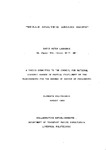SKILLS ANALYSIS ABOARD SHIPS
| dc.contributor.author | LAWRENCE, DAVID PETER | |
| dc.contributor.other | Faculty of Science and Engineering | en_US |
| dc.date.accessioned | 2013-09-13T12:54:58Z | |
| dc.date.available | 2013-09-13T12:54:58Z | |
| dc.date.issued | 1988 | |
| dc.identifier | NOT AVAILABLE | en_US |
| dc.identifier.uri | http://hdl.handle.net/10026.1/1717 | |
| dc.description.abstract |
This thesis presents a detailed description, based upon the literature available, of shipboard organization and social structure, together with a descriptive summary of the dynamic environment in which ships operate. The literature relating to job and task analysis is also reviewed and examined for its relevance to shipboard studies. A picture emerges of an industry being forced by technical, social, legal and economic factors to rationalize the use of its manpower resources. It is found that many authors propose the adoption of a matrix manning model. The thesis is proposed that matrix manning is technically viable as a method of manning all types of merchant vessels. A methodology is developed which allows identification, observation, recording and analysis of shipboard operational functions. The methodology involves a unique amalgamation of Fine & Wiley's Functional Job Analysis with ratings of the frequency, criticality and difficulty of functional performance. The identified functions necessary for ship operation are detailed. A rationale is included for the selection of ship types used for data collection during the research project. The process of observation and shipboard data gathering is described. The problems which arose with regard to data collection are mentioned together with their methods of solution. The collected results are analyzed and show that there are three technical classes of ships for consideration when studying manpower problems. General concepts of function significance and complexity are derived from the results. These concepts are used to support the argument that there exist two levels of functional performance aboard ships. These separate performance levels are shown to be essential to the introduction of matrix manning. The concept of dual level performance is merged with the information from the function profiles (which illustrate the qualitative nature of shipboard work). This combination of data is then used to demonstrate that shipboard functions may be reclustered in an innovative fashion which supports the introduction of matrix manning. Finally, the concepts of function significance and complexity are shown to have important implications in the field of manpower studies. In particular it is shown that conventional linear manpower policies are inadequate and that a two dimensional structure provides greater insight into the successful utilization of human resources. | |
| dc.description.sponsorship | DEPARTMENT OF TRANSPORT MARINE DIRECTORATE, LIVERPOOL POLYTECHNIC | en_US |
| dc.language.iso | en | en_US |
| dc.publisher | University of Plymouth | en_US |
| dc.title | SKILLS ANALYSIS ABOARD SHIPS | en_US |
| dc.type | Thesis | |
| plymouth.version | Full version | en_US |
| dc.identifier.doi | http://dx.doi.org/10.24382/4038 |
Files in this item
This item appears in the following Collection(s)
-
01 Research Theses Main Collection
Research Theses Main


